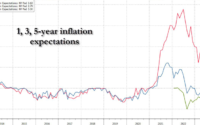The interest rate on the country’s benchmark mortgage product edged downward for the first time since early March, but that doesn’t mean the housing market will see a reprieve.
The 30-year fixed-rate mortgage averaged 5.1% for the week ending April 28, according to data released by Freddie Mac
FMCC,
on Thursday. That’s down one basis point from the previous week — one basis point is equal to one hundredth of a percentage point, or 1% of 1%.
Last week was the first time that mortgage rates had surpassed 5% since 2011. A year, the average rate on the 30-year home loan was below 3%.
The 15-year fixed-rate mortgage, meanwhile, rose two basis points to an average of 4.4% over the past week. The 5-year Treasury-indexed hybrid adjustable-rate mortgage averaged 3.78%, rising three basis points from the previous week.
The moderation in mortgage rates is a reflection of movements in the market for long-term bonds. Notably, the yield on the 10-year Treasury
TMUBMUSD10Y,
rose above 2.9% earlier in the week before settling lower, which indicated how concerns about the COVID situation in China were weighing on investors.
“Markets are increasingly weighing that with Beijing potentially following in Shanghai’s mass quarantine footsteps, the outlook for economic growth is darkening, which may affect the U.S. economy,” said George Ratiu, manager of economic research at Realtor.com.
Despite this brief setback, mortgage rates have risen at the fastest pace in over 40 years, Freddie Mac chief economist Sam Khater said in the report. And that trend is likely to continue, given that inflation remains hot.
“‘Buyers of a median-price home are looking at a monthly mortgage payment that is almost 50% higher than it was a year ago.’”
That will prompt the Federal Reserve to hike rates and adjust its holdings of mortgage-backed securities in the coming months, which will put pressure on mortgage rates. It’s tough to understate how disruptive the historic rise in mortgage rates over the past few months has been.
“Buyers were already constrained by low inventories, which have been driving prices higher,” Rubeela Farooqi, chief U.S. economist at High Frequency Economics, wrote in a research note. “Sustained increases in mortgage rates will be an additional headwind for home sales going forward.”
The most recent data for both pending home sales and mortgage applications released Wednesday painted a picture of weakening demand from home buyers. The combination of high prices and high interest rates has made purchasing a home significantly less affordable, and it’s likely that some families have been pushed out of the home-buying market — at least for the time being.
“Buyers of a median-price home are looking at a monthly mortgage payment that is almost 50% higher than it was a year ago, adding an extra $580 to their monthly expenses,” Ratiu said. “It is not surprising that many are stepping back from the market, hoping that conditions will improve.”
For those Americans who persist, they will be reward by a less competitive market, which could give them more homes to choose from and a lower likelihood of facing a bidding war.


